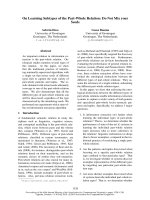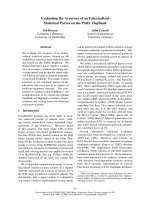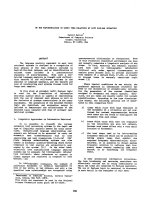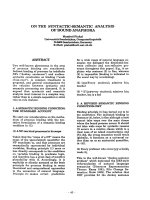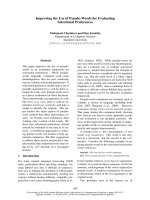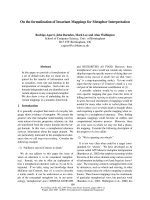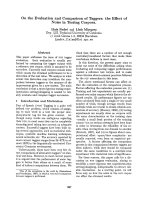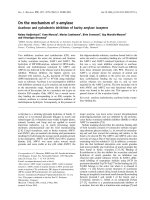Báo cáo khoa học: "On the formalization of Invariant Mappings for Metaphor Interpretation" pot
Bạn đang xem bản rút gọn của tài liệu. Xem và tải ngay bản đầy đủ của tài liệu tại đây (97.11 KB, 4 trang )
Proceedings of the ACL 2007 Demo and Poster Sessions, pages 109–112,
Prague, June 2007.
c
2007 Association for Computational Linguistics
On the formalization of Invariant Mappings for Metaphor Interpretation
Rodrigo Agerri, John Barnden, Mark Lee and Alan Wallington
School of Computer Science, Univ. of Birmingham
B15 2TT Birmingham, UK
Abstract
In this paper we provide a formalization of
a set of default rules that we claim are re-
quired for the transfer of information such
as causation, event rate and duration in the
interpretation of metaphor. Such rules are
domain-independent and are identified as in-
variant adjuncts to any conceptual metaphor.
We also show a way of embedding the in-
variant mappings in a semantic framework.
1 Introduction
It is generally accepted that much of everyday lan-
guage shows evidence of metaphor. We assume the
general view that metaphor understanding involves
some notion of events, properties, relations, etc. that
are transferred from the source domain into the tar-
get domain. In this view, a metaphorical utterance
conveys information about the target domain. We
are particularly interested in the metaphorical utter-
ances that we call map-transcending. Consider the
following example:
(1) “McEnroe starved Connors to death.”
We do not address in this paper the issue of
when an utterance is to be considered metaphor-
ical. Instead, we aim to offer an explanation of
how a metaphorical utterance such as (1) can be in-
terpreted. If we infer, using our knowledge about
McEnroe and Connors, that (1) is used to describe
a tennis match, it can be understood as an exam-
ple of the conceptual metaphors (or, in our termi-
nology, ‘metaphorical views’) DEFEATAS DEATH
and NECESSITIES AS FOOD. However, these
metaphorical views would not contain any relation-
ship that maps the specific manner of dying that con-
stitutes being starved to death (we say that “starv-
ing” is a map-transcending entity). Yet one could
argue that the manner of Connors’s death is a cru-
cial part of the informational contribution of (1).
A possible solution would be to create a new
view-specific mapping that goes from the form of
killing involved in starving to death to some process
in sport, but such enrichment of mappings would be
needed for many other verbs or verbal phrases that
refer to other ways in which death is brought about,
each requiring a specific specific mapping when oc-
curring in a metaphorical utterance. Thus, finding
adequate mappings could become an endless and
computational intensive process. Moreover, there
are even cases in which we may not find a plausi-
ble mapping. Consider the following description of
the progress of a love affair:
(2) “We’re spinning our wheels.”
It is not very clear what could be a target corre-
spondent for ‘wheels’. We have developed an AI
system called ATT-Meta for metaphor interpretation
(Barnden et al., 2002) that employs reasoning within
the terms of the source domain using various sources
of information including world and linguistic knowl-
edge. The reasoning connects unmapped ideas used
by utterances, such as wheels and starving, to other
source-domain ideas for which a mapping is already
known. These known mappings may be constituents
of particular metaphorical view, but previous work
(Barnden et al., 2003; Wallington et al., 2006) has
109
shown evidence that there are metaphorical aspects
(such as causal relations between events) that, sub-
ject to being called, invariantly map from source to
target (we call these mappings View-Neutral Map-
ping Adjuncts or VNMAs) irrespective of whatever
specific metaphorical views are in play. These allow
many mapping effects, which would otherwise have
to be duplicated across all view-specific mappings,
to be factored out into separate mappings. In our
approach, source domain reasoning takes place in a
special, protected computational context that we call
the “pretence space”. We use the term ‘reality’ to
refer to the space outside the pretence where propo-
sitions are about reality as the understander sees it.
Currently ATT-Meta implements the VNMAs by
including them in view-specific rules, but we plan to
make the system more modular and its view-specific
mappings more economical by implementing VN-
MAs as separate default rules. The first step to-
wards that goal is to provide a formalization of these
mappings and to show their role in metaphor in-
terpretation. In order to do so, we provide a se-
mantic representation of how these VNMAs work
by adopting Segmented Discourse Representation
Theory (Asher and Lascarides, 2003) to capture the
main aspects of the ATT-Meta approach.
2 Knowledge and Inference
If (1) is being used metaphorically to describe the
result of a tennis match, a plausible target interpre-
tation would be that McEnroe defeated Connors in a
slow manner by performing some actions to deprive
him of his usual playing style. Assuming a com-
monsensical view of the world, a within-pretence
meaning would be that McEnroe starved Connors to
death in the real, biological sense. The inferencing
within the pretence can then conclude that McEnroe
caused Connors’s death by depriving or disabling
him. Leaving some details aside, the partial logical
form (in the pretence) of the metaphorical utterance
(1) may be represented as follows (without taking
into account temporal issues):
(i) ∃x, y, e(McEnroe(x) ∧ Connors(y)
∧starve − to − death(e, x, y))
This says that there is an event e of x starving y to
death (we also use the notion of event to describe sit-
uations, processes, states, etc.). It may be suggested
that if we were trying to map the partial expression
(i), its correspondent proposition in the target could
be expressed by this formula:
(ii) ∃x, y, e(McEnroe(x) ∧ Connors (y)∧
defeat(e, x, y))
According to this, the event of x defeating y in
the reality would correspond to the event of x starv-
ing y to death in the pretence. However, by say-
ing “McEnroe starved Connors to death” instead of
simply “McEnroe killed Connors” the speaker is not
merely intending to convey that McEnroe defeated
Connors, but rather something related to the man-
ner in which Connors was defeated. Following this,
starving may be decomposed into the cause e
1
and
its effect, namely, “being deprived of food”:
(iii) ∃x, y, z, e
1
, e
2
, e
3
(McEnroe(x)∧
Connor s(y) ∧ f ood(z) ∧ starve(e
1
, x, y) ∧
death(e
2
, y) ∧ deprived(e
3
, y, z)∧
cause(e
1
, e
3
))
Now, by means of lexical information regarding
“starving”, it can be inferred that McEnroe deprived
Connors of a necessity (see, e.g., Wordnet), namely,
of the food required for his normal functioning (the
NECESSITIES AS FOOD metaphorical view would
provide mappings to transfer food to the type of
shots that Connors needs to play his normal game).
In other words, Connors is defeated by the partic-
ular means of depriving him of a necessity (food)
which means that being deprived causes Connors’s
defeat. This fits well with the interpretation of (1)
where McEnroe’s playing deprived Connors of his
usual game. Moreover, linguistic knowledge also
provides the fact that starving someone to death is a
gradual, slow process. The result of within-pretence
inferencing may be represented as follows:
(iv) ∃x, y, z, e
1
, e
2
, e
3
(McEnroe(x)∧
Connor s(y) ∧ f ood(z) ∧ starve(e
1
, x, y) ∧
death(e
2
, y) ∧ deprived(e
3
, y, z)∧
cause(e
1
, e
3
)∧cause(e
3
, e
2
)∧rate(e
1
, slow))
‘Slow’ refers to a commonsensical concept in the
pretence related to the progress rate of starving.
Now, the existing mapping DEFEAT AS DEATH
can be applied to derive, outside the pretence, that
McEnroe defeated Connors, but no correspondences
110
are available to account for the fact that McEnroe
caused the defeat of Connors by depriving him of
his normal play. We appear to have a problem also
to map the slow progress rate of a process like starv-
ing.
3 VNMAs in a Semantic Framework
In the ATT-Meta approach to metaphor interpreta-
tion, the mappings of caused and rate discussed
above are accomplished by a type of default map-
pings that we specify as VNMAs (the Causation
and Rate VNMAs, respectively; see (Wallington and
Barnden, 2006) for an informal but detailed de-
scription of a number of VNMAs). The idea is
that there are relationships and properties (causation,
rate, etc.) between two events or entities that iden-
tically transfer from the pretence to the reality. We
use the → symbol to express that this mapping is a
default. The VNMAs involved in the interpretation
of (1) can be represented as follows:
Causation: ∀e
1
, e
2
(cause(e
1
, e
2
)
pret
→
cause(e
1
, e
2
)
rlt
)
The Rate VNMA transfers the qualitative rate of
progress of events in the source domain to the qual-
itative rate of progress of its mappee:
Rate: ∀e, r(rate(e, r)
pret
→ rate(e, r)
rlt
)
Embedding the VNMAs in a semantic framework
for metaphor interpretation is useful as a first step
towards their implementation as default rules in the
ATT-Meta system, but it is also interesting in its
own right to show the contribution that the ATT-
Meta approach can make towards the semantics of
metaphor. In the somewhat simplified discussion
on the within-pretence reasoning and mappings nec-
essary to interpret metaphorical utterances such as
(1), we have been using various sources of informa-
tion that interact in the processing of the utterance:
a) View-specific mappings provided by the relevant
metaphorical views (DEFEAT AS DEATH and NE-
CESSITIES AS FOOD); b) Linguistic and contex-
tual information necessary for reasoning in the pre-
tence; c) Relations and properties between events
such as causation and rate that are inferred in the
pretence; d) VNMAs that transfer within-pretence
event relations and properties to reality.
There are two prominent computationally-
oriented semantic approaches (Hobbs, 1996) and
(Asher and Lascarides, 2003) that take into account
contextual and linguistic information and stress the
importance of relations between text segments in
discourse interpretation. In fact, the incorporation
of the above types of information ties in well with
the SDRT (Asher and Lascarides, 2003) view of
language understanding. For example, we can think
of the pretence space as a Segmented Discourse
Representation Structure (SDRS) representing the
result of within-pretence inference which can be
mapped by using various view-specific and invariant
mappings to reality. In other words, we can see the
pretence SDRS as the input for what the ATT-Meta
system does when interpreting metaphor – it will
reason with it, producing an output of inferred
reality facts which we may also represent by means
of an SDRS. The result of reasoning in the pretence
to interpret (1) would now looks as follows:
PRET:
α, β, γ
α:
x, y, e
1
McEnroe(x)
Connors(y)
starve(e
1
, x, y)
β:
e
2
death(e
2
, y)
γ:
e
3
,z
food(z)
deprived(e
3
, y, z)
cause(e
1
, e
3
)
cause(e
3
,e
2
)
rate(e
1
,slow)
−→
where α and β are labels for DRSs representing
events, PRET for a pretence space and −→ map-
pings (VNMAs and central mappings) needed in the
interpretation of the metaphorical utterance. Impor-
tantly, the VNMAs would pick upon aspects such
as causation and rate from pretence to transfer them
to reality producing an output which could also be
represented as a SDRS:
RLT:
α, β, γ
α:
x, y, e
1
McEnroe(x)
Connors(y)
tennis-play(e
1
, x, y)
β:
e
2
defeat(e
2
, y)
γ:
e
3
,z
necessity(z)
deprived(e
3
, y, z)
cause(e
1
, e
3
)
cause(e
3
,e
2
)
rate(e
1
,slow)
Note that this formal representation integrates the
systematicity of mapping invariantly certain aspects
of metaphorical utterances by formulating them as
relations between events that can be represented as
111
relations and properties of DRSs. For this purpose
we need to modify the construction rules of SDRSs
to be able to infer properties and relations involving
individuals and not only DRSs’ labels. In addition
to this, we have shown in the previous section how
ATT-Meta source domain reasoning captures the in-
teraction of the various sources of knowledge used
to infer causation and rate in the pretence. Further-
more, studying the interaction between VNMAs and
discourse relations may allow us to extend the study
of metaphor to discourse.
4 Concluding Remarks
Following the ATT-Meta claim metaphors often con-
vey crucial information via VNMAs, we can re-
analyze example (1) so that the effects of the NE-
CESSITIES AS FOOD mapping are obtained by
VNMAs. In the pretence, the food is something
Connors needs for proper functioning: i.e., it is nec-
essary that Connors have the food in order to func-
tion properly. The necessity here is covered by the
Modality VNMA, which maps relative degrees of
necessity, possibility, obligation, etc., from pretence
to reality. Moreover, the functioning properly would
be covered by the Function and Value-Judgement
(levels of goodness, importance, etc. map identi-
cally to levels of goodness, etc.). So all that is left is
the possession which could be covered by a STATE
AS POSSESSION mapping.
Formal semantic approaches (Asher and Las-
carides, 2003) do not account for metaphorical ut-
terances including map-transcending entities. Other
works (Carbonell, 1982; Hobbs, 1990; Martin,
1990; Narayanan, 1997) have addressed source do-
main reasoning to a limited extent, but its role in
metaphor interpretation has not previously been ad-
equately investigated. Moreover, map-transcending
entities pose a problem for analogy-based ap-
proaches to metaphor interpretation (Falkenhainer
et al., 1989), which require the discovery of an
elaborate structural similarity between the source
and target domains and/or the imposition of un-
mapped source domain structures on the target do-
main, whereas part of our approach is that the un-
mapped source domain structure introduced by the
utterance is by default not carried over.
Acknowledgements Supported by EPSRC
EP/C538943/1 and GR/M64208 grants.
References
Nicholas Asher and Alex Lascarides. 2001. The seman-
tics and pragmatics of metaphor. In P. Bouillon and F.
Busa, editors, The Language of Word Meaning, pages
262–289. Cambridge University Press.
Nicholas Asher and Alex Lascarides. 2003. Logics of
Conversation. Cambridge University Press.
John Barnden, Sheila Glasbey, Mark Lee, and Alan
Wallington. 2002. Reasoning in metaphor under-
standing: The att-meta approach and system. In 19th
Conference on Computational Linguistics (COLING-
2002).
John Barnden, Sheila Glasbey, Mark Lee, and
Alan Wallington. 2003. Domain-transcending
mappings in a system for metaphorical reasoning.
In Conference Companion to the 10th Conference
of the European Chapter of the Association for
Computational Linguistics (EACL 2003), pages
57–61.
Jaime Carbonell. 1982. Metaphor: An inescapable
phenomenon in natural-language comprehension. In
W. Lehnert and M. Ringle, editors, Strategies for Nat-
ural Language Processing, pages 415–434. Lawrence
Erlbaum, Hillsdale, NJ.
BrianFalkenhainer, Kenneth Forbus, and Dedre Gentner.
1989. The structure-mapping engine: algorithm and
examples. Artificial Intelligence, 41(1):1–63.
Jerry Hobbs. 1990. Literature and Cognition. CSLI,
Lecture Notes, Stanford.
Jerry Hobbs. 1996. An approach to the structure of dis-
course. In D. Everett, editor, Discourse: Linguistic,
Computational and Philosophical Perspectives.
James Martin. 1990. A computational model of
metaphor interpretation. Academic Press, New York.
Srini Narayanan. 1997. KARMA: Knowledge-based ac-
tion representations for metaphor and aspect. Ph.D.
thesis, Computer Science Division, EECS Depart-
ment, University of California, Berkeley, August.
Alan Wallington and John Barnden. 2006. Similarity as
a basis for metaphor: Invariant transfer and the role
of VNMAs. Technical Report CSRP-06-02, School of
Computer Science, Univ. of Birmingham, December.
Alan Wallington, John Barnden, Sheila Glasbey, and
Mark Lee. 2006. Metaphorical reasoning with an eco-
nomical set of mappings. Delta, 22(1).
112

